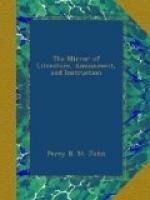A revolution like the French, which presented to their eyes such terrible spectacles, must have left some traces in their physical or intellectual constitution. At the end of this bloody drama, the mind, bewildered by the late dreadful scenes, was unable to feel those sweet and peaceable emotions, in which it had formerly delighted; as the palate, having long been at rest, and now become blunted, must require high-seasoned dishes, to excite an appetite. The reign of the Directory, therefore is that of Romances a la Radcliffe, as well as of Sauces a la Provencale. Fortunately, the eighth of Brumaire pulled down the five Directors, together with their saucepans.
Under the Consulship, and during the empire, the art of cooking, thanks to the labours of Beauvilliers, Balaine, and other artists, made new and remarkable improvements. Among the promoters of the gastric science, the name of a simple amateur makes a distinguished figure—it is Grisnod de la Reyniere, whose almanac the late Duke of York called the most delightful book that ever issued from the press. We may affirm, that the Almanach des Gourmands made a complete revolution in the language and usages of the country.
We are yet too near the restoration to determine the degree of influence it had on cookery in France. The restoration has introduced into monarchy the representative forms friendly to epicurism, and in this respect it is a true blessing—a new era opened to those who are hungry.
M. Jarrin’s fourth edition contains upwards of 500 receipts in Italian confectionery, with plates of improvements, &c. like a cyclopaedian treatise on mechanics; and when our readers know there are “seven essential degrees of boiling sugar,” they will pardon the details of the business of this volume. The “degrees” are—1. Le lisse, or thread, large or small; 2. Le perle, or pearl, le soufflet, or blow; 4. La plume, the feather; 5. Le boulet, the ball, large or small; 6. Le casse, the crack; and, 7. the caramel. So complete is M. Jarrin’s system of confectionery, that he is “independent of every other artist;” for he even explains engraving on steel and on wood. What a host of disappointments this must prevent!
If we look further into, or “drink deep” of the art of confectionery, we shall find it to be a perfect Microcosm—a little creation; for our artist talks familiarly of “producing picturesque scenery, with trees, lakes, rocks, &c.; gum paste, and modelling flowers, animals, figures, &c.” with astonishing mimic strife. We must abridge one of these receipts for a “Rock Piece Montee in a lake.”




